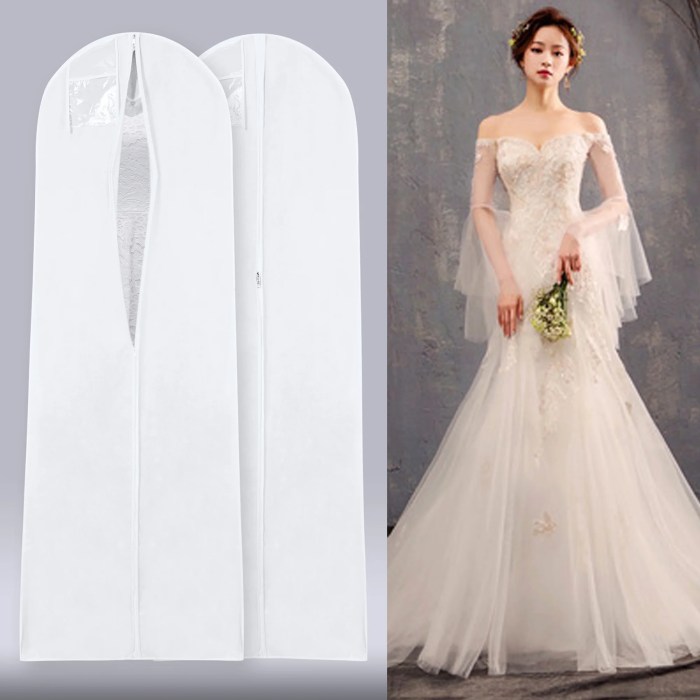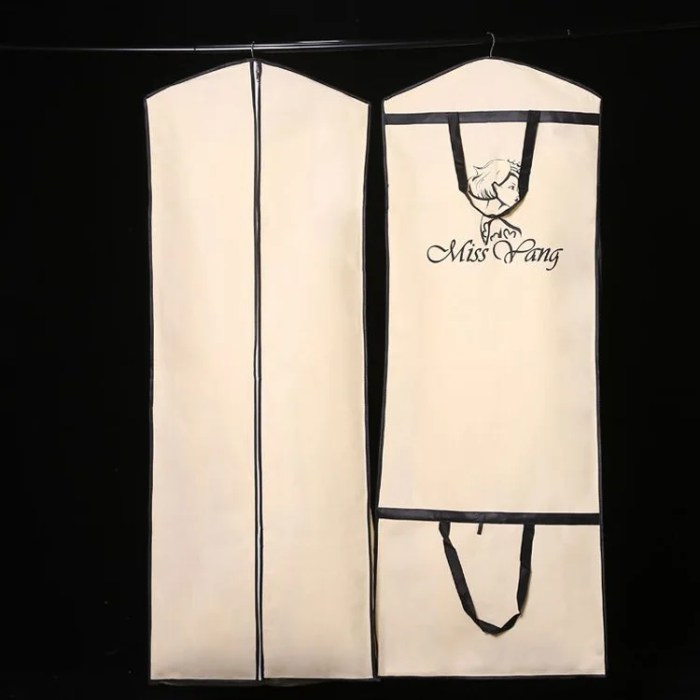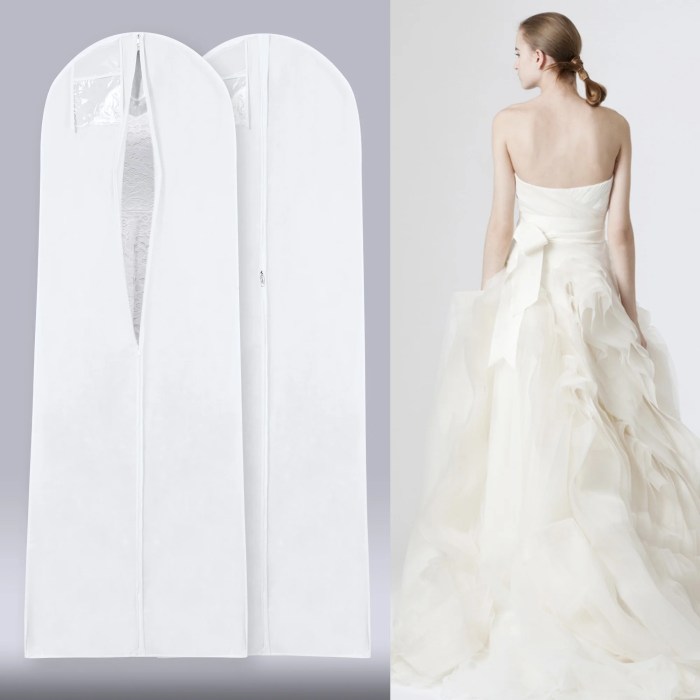Garment Bag Wedding Dress Safe Storage & Transport
Types of Garment Bags for Wedding Dresses

Source: walmartimages.com
Garment bag wedding dress – Choosing the right garment bag is crucial for preserving your wedding dress. Several factors influence the choice, including material, closure mechanism, and overall quality. Understanding these differences ensures your dress remains pristine throughout transportation and storage.
Garment Bag Materials
Wedding dress garment bags are available in various materials, each with its own advantages and disadvantages. Common materials include non-woven fabrics, breathable fabrics, and plastic.
- Non-woven fabrics: These are lightweight, affordable, and offer decent protection against dust and minor debris. However, they may not offer the same level of protection against moisture or extreme temperatures as other materials.
- Breathable fabrics: Materials like cotton or canvas allow air circulation, preventing moisture buildup and mildew. This is particularly important for delicate fabrics like silk or lace. They tend to be more expensive than non-woven options.
- Plastic: Plastic garment bags offer excellent protection against moisture and dust. However, they lack breathability, potentially leading to moisture build-up and damage to the dress if not properly ventilated.
Garment Bag Closure Mechanisms

Source: alicdn.com
The closure mechanism affects the security and ease of use of the garment bag. Popular options include zippers, drawstrings, and hook-and-loop fasteners.
- Zippers: Offer the most secure closure, protecting the dress from dust and moisture. However, they can sometimes snag delicate fabrics.
- Drawstrings: Provide a simple and secure closure, but may not be as dust-proof as zippers. They are often found on more budget-friendly options.
- Hook-and-loop fasteners: Easy to use, but may not be as secure as zippers or drawstrings, offering less protection against dust and moisture.
Basic vs. Premium Garment Bags
The difference between basic and premium garment bags lies primarily in material quality, features, and overall durability. Premium bags often utilize higher-quality, breathable fabrics, reinforced seams, and additional features like reinforced handles or internal compartments for accessories.
Comparison of Garment Bag Types
| Type | Material | Price Range | Key Features |
|---|---|---|---|
| Basic Non-Woven | Non-woven polypropylene | $10 – $20 | Lightweight, affordable, drawstring closure |
| Breathable Fabric | Cotton canvas | $20 – $50 | Breathable, durable, zipper closure |
| Premium Zippered | High-quality polyester with reinforced seams | $50 – $100 | Durable zipper, reinforced handles, internal pockets |
| Luxury Garment Bag | Silk-lined breathable fabric | $100+ | Luxury materials, multiple compartments, acid-free tissue paper included |
Protecting the Wedding Dress During Transport
Properly packing your wedding dress is essential to prevent wrinkles, creases, and damage during transport. Careful folding, the use of protective materials, and appropriate transportation methods all contribute to its safe arrival.
Packing a Wedding Dress for Transport
- Lay the dress flat on a clean, soft surface.
- Gently fold the dress in half, aligning the seams and avoiding sharp creases.
- Wrap the dress in acid-free tissue paper to prevent snags and discoloration.
- Place the wrapped dress into the garment bag, ensuring it lies flat and wrinkle-free.
- Secure the garment bag using the closure mechanism.
- If hanging the dress is preferable, use a padded hanger and a protective cover before placing it in the garment bag.
Preventing Wrinkles and Creases
To minimize wrinkles and creases, avoid tight packing and ensure the dress has ample space within the garment bag. Hanging the dress, when possible, is often the best method for preventing creases. For longer journeys, consider using a garment bag with a stiff structure to maintain its shape.
Transportation Methods
The choice of transportation method influences how you handle the garment bag. For car travel, ensure the garment bag is placed securely to prevent shifting or damage. For air travel, consider placing the garment bag in a protective suitcase to prevent crushing or damage from baggage handling. For train travel, store the garment bag in an overhead compartment or a secure location to avoid accidental damage.
Garment Bag Storage and Preservation
Proper storage is crucial for maintaining the pristine condition of your wedding dress. Controlling environmental factors like temperature, humidity, and light exposure, as well as preventing pest infestations, will help to preserve its beauty for years to come.
Ideal Storage Conditions
Store your wedding dress in a cool, dry, and dark place. Ideal temperature and humidity levels are typically between 65-70°F (18-21°C) and 40-50% relative humidity. Avoid direct sunlight, which can cause discoloration and fabric degradation. A climate-controlled closet or storage unit is ideal.
Preventing Yellowing and Mildew
Yellowing and mildew are common problems for stored fabrics. Ensure the dress is completely dry before storage, and consider using a desiccant pack to absorb excess moisture. Regularly check the dress for any signs of damage or discoloration.
Storage Checklist
- Clean the dress professionally before storage.
- Allow the dress to air dry completely.
- Wrap the dress in acid-free tissue paper.
- Place the dress in a breathable garment bag.
- Store the bag in a cool, dry, dark place.
- Check the dress periodically for signs of damage.
Pest Deterrents
While mothballs and cedar chips are traditional pest deterrents, their strong odors can potentially damage delicate fabrics. Consider using natural alternatives such as lavender sachets or sachets containing dried herbs.
Garment Bag Alternatives and Enhancements

Source: walmartimages.com
While garment bags are a popular choice, other storage solutions exist. Each offers different levels of protection and suitability depending on the dress and storage conditions. Understanding these alternatives and enhancing your garment bag setup ensures optimal protection.
Alternatives to Garment Bags
- Dress boxes: Offer excellent protection against dust and light, but may not be suitable for all dress styles. They often lack breathability.
- Vacuum-sealed bags: Compact storage, but can cause wrinkles and potentially damage delicate fabrics if not used carefully.
Issues with Unsuitable Storage
Using unsuitable storage methods can lead to yellowing, mildew, wrinkles, and fabric damage. Choosing the right method is critical to long-term preservation.
Custom-Sized Garment Bags
For unusually shaped or large wedding dresses, consider creating a custom-sized garment bag using heavy-duty fabric and a sturdy zipper. Professional alterations shops often offer this service.
Accessories for Enhanced Protection
- Acid-free tissue paper
- Desiccant packs
- Lavender sachets
- Dress forms (for display)
Post-Wedding Dress Care in the Garment Bag
Even after professional cleaning, some post-wedding care is necessary before long-term storage. Addressing minor stains, allowing the dress to air out, and monitoring its condition during storage are crucial for preserving its quality.
Cleaning and Spot Treatment
Before storing, address any minor stains using a gentle cleaning solution appropriate for the fabric type. Consult a professional dry cleaner for significant stains or damage.
Air Drying After Cleaning, Garment bag wedding dress
After professional cleaning, allow the dress to air dry completely before placing it in the garment bag. This prevents moisture build-up and potential mildew growth.
Handling After Long-Term Storage
After long-term storage, carefully inspect the dress for any signs of damage. Gently air out the dress before handling or displaying it. Professional cleaning may be necessary before reuse or display.
Signs of Damage
Signs of damage include yellowing, discoloration, mildew growth, holes, tears, or significant wrinkling. Professional restoration or preservation may be necessary if significant damage is detected.
Question Bank: Garment Bag Wedding Dress
Can I use a regular garment bag for my wedding dress?
While possible, a dedicated wedding dress garment bag offers superior protection due to its size, material, and features. Regular bags might not provide enough space or protection against wrinkles and damage.
How often should I check on my stored wedding dress?
Inspect your dress every 6-12 months for any signs of damage, discoloration, or pest infestation. Address any issues promptly.
What if my wedding dress is unusually large or shaped?
Consider a custom-made garment bag or explore alternative storage solutions like a large, acid-free box with ample padding.
Are mothballs safe for wedding dresses?
While mothballs deter pests, their strong odor can potentially damage delicate fabrics. Consider cedar chips or lavender sachets as safer alternatives.



















